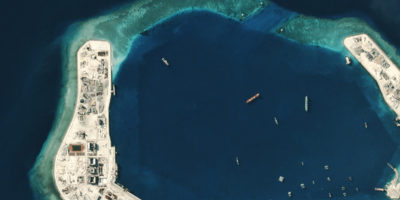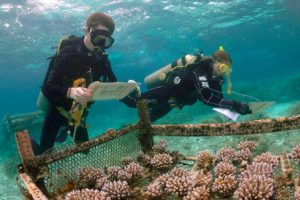In the late 1980s, marine biologist John McManus and his colleagues made a surprising discovery while studying near-shore Philippine reefs in the South China Sea: Some fish species seemed to disappear, only to reappear a year or two later. “We figured they weren’t coming from other parts of the coast because the entire South China Sea, with the exception of Brunei, is equally overfished,” says McManus, a professor of marine biology and fisheries at the University of Miami.
The researchers’ hunch, which proved to be correct, was that larvae were floating to the near-shore reefs from the Spratlys — an offshore archipelago that lies between Vietnam and the Philippines and is a key spawning ground for one of the world’s most productive fisheries. Scientists later reported that the South China Sea, which is the size of India and has hundreds of islands and islets, has some of the highest marine biodiversity on earth, with 571 known species of reef corals alone.
But the South China Sea’s rich natural heritage, long threatened by overfishing, now faces a new ecological danger: A campaign by China to build artificial islands on disputed reefs in the Spratlys and elsewhere in the sea. China’s island-building initiative signals an aggressive stance intended to secure dominance in the South China Sea, a strategic area that contains some of the world’s busiest shipping lanes and is a potential source of oil deposits.
Over the past several years, Chinese President Xi Jinping has ordered engineers to pile sand onto some of the sea’s disputed offshore reefs, mostly in the Spratlys, with the apparent goal of building military bases there. Satellite imagery shows that China has so far constructed seven artificial islands in the Spratlys, and added ports, radar equipment, and airstrips. Three of the seven islands were designed as military bases, U.S. military officials say, and one has an anchorage larger than Hawaii’s Pearl Harbor. Marine scientists worry that the next target for dredging and construction will be Scarborough Shoal off the Philippine coast — which, like the Spratlys, is also known for its rich biodiversity.
Based on satellite information, computer-modeling data, and previous studies of human impacts on coral reefs, scientists are concerned that China’s campaign may be causing irreparable damage. Coral reefs in the Spratlys and other offshore regions, including the Paracel Islands and Scarborough Shoal, supply larvae for fisheries that feed hundreds of millions of people. They also are a living seed bank that could help the region’s marine communities deal with the long-term impacts of climate change.
“You’re talking about destroying the equivalent of seven worldwide natural heritage areas,” says one expert.
The scientists’ concerns stem partly from the island-construction process. Ships more than 300 feet long have been dredging deep-water channels and harbors, while smaller boats have dredged in shallower waters around reef flats and lagoons by digging up corals with their propellers, according to a forthcoming study by McManus. Both activities produce plumes of sand and silt that coat living reefs and block their access to sunlight. Deep-water dredging can also lower the existing seafloor by up to 30 feet, the study said, changing wave patterns and inhibiting the growth of the red algae that are essential to reef calcification and sedimentation.
Additional local and regional damage to reefs and fish stocks will occur, scientists say, if China turns some of the new artificial islands on the Spratlys into harbors for the country’s commercial fishing fleet.
“What you’re essentially talking about is destroying the equivalent of seven worldwide natural heritage areas,” says Kent Carpenter, a professor at Old Dominion University in Virginia who has studied coral reefs in the Philippines for four decades.
The long-term environmental impacts of China’s activities on the seven Spratly reefs it occupies may never be known unless the Chinese military allows independent experts to conduct research there, scientists say. But nearly six square miles of artificial islands have been built recently on disputed reefs in the sea, primarily in the greater Spratly Islands, according to the McManus study. Vietnam, Malaysia, Taiwan, and the Philippines accounted for just a tiny percentage of that construction, the study said, while China’s activities were responsible for 99 percent of the resulting damage to offshore coral reefs.
Although six square miles may seem like a small area, the McManus study indicates that the total damage from island building and dredging has already affected more than 10 percent of the Spratlys’ total shallow reef area.
Slide bar from left to right to view satellite images showing construction on Gaven Reef in the South China Sea. (Image courtesy of the Maritime Awareness Project)
China has long claimed offshore territories in as much as 90 percent of the South China Sea. Its claims overlap with competing ones by Vietnam, the Philippines, and other nations. Tensions over the claims have simmered for decades, and some countries have conducted limited land reclamation work on disputed islands and atolls.
In July, the Philippines won a landmark case at a United Nations tribunal, successfully challenging China’s territorial claims in the sea. (Both McManus and Carpenter worked as paid science advisors to the Philippines on the case.) But President Xi has vowed to ignore the tribunal’s ruling, and some analysts think that China’s island-building efforts could raise geopolitical tensions and eventually lead to military conflict with rival claimants or the United States.
At the center of this drama lie the 12 main islets and more than 100 coral reefs of the Spratlys. Scientists describe the Spratlys as biological “stepping stones” for successive generations of corals and fish, meaning that larvae float hundreds of miles toward the Spratlys on ocean currents and stop in eddies near their corals to breed. Successive generations then travel further to create or repopulate marine communities elsewhere in the South China Sea, the Gulf of Thailand, or the Coral Triangle between Indonesia, the Philippines, and the Solomon Islands.
The Spratlys are “positioned very neatly to transfer biodiversity” across open water, says Clive Wilkinson, the former lead coordinator for the non-profit Global Coral Reef Monitoring Network. In addition to producing larvae, the Spratly reefs also function as biological “roadside cafes” for migratory fish, including tuna, that travel through the South China Sea on their way to the Indian Ocean and stop at the Spratlys to feed, he adds. “So any damage to them [the reefs] will have long-term repercussions,” says Wilkinson.
The South China Sea is chronically understudied, in large part because so many of its offshore rocks, reef, and atolls are military-patrolled zones that scientists cannot access. Chou Loke Ming, a coral reef expert at the National University of Singapore, says that nearly all on-the-ground scientific research on the South China Sea has so far been confined to near-shore areas where territorial ownership is not as murky as it is in the Spratlys.
But the existing science already paints a portrait of abundant biodiversity. For example, a 2015 computer-modeling study found that larvae from the coral species Acropora millepora, whose intricate branches help to shelter other organisms, float from the Spratlys across large swathes of the South China Sea and the Coral Triangle, “further highlighting the importance of the Spratly Islands to the greater region.” And a 2015 species survey said previous estimates of the South China Sea’s reef biodiversity have been “exceedingly low,” largely because of a lack of data for the Spratlys and some reefs off the Philippine island of Luzon.
Scientists think the Spratly reefs’ genetic diversity could help them weather the impacts of storms, ocean acidification, and other impacts linked to global warming. Larvae from the reefs could help repopulate distant marine communities that are less biologically resilient. If patches of biodiversity “blink out” occasionally across the South China Sea, “the idea is that if you have a lot of exchange, they’ll be reseeded in the near future,” says Eric Treml, a marine biologist at the University of Melbourne who has created computer models of regional fish-larvae movement.
Slide bar from left to right to view satellite images showing construction on Mischief Reef in the South China Sea. (Image courtesy of the Maritime Awareness Project)
Scientists say China’s island building may imperil that system of genetic diversity and biological connectivity. But how great is the cumulative threat from reef building and fishing? McManus estimates that China has already caused 55 square miles of “decadal-scale” damage through giant-clam harvesting and seafloor dredging near its new islands. That is worrying because seafloor dredging can kill corals by blocking their access to sunlight as has happened near Australia’s Great Barrier Reef, where sediment plumes extended for up to 28 miles from a seafloor dredging site.
By contrast, only 6.5 square miles of South China Sea reefs have been damaged by China’s island building and dredging for channel and harbor projects, according to McManus’ forthcoming study. Yet he describes that damage as “essentially permanent.”
“You cannot grow a coral on an airstrip because they don’t grow on airstrips; they grow underwater,” says Edgardo D. Gomez, a marine biologist and a professor emeritus at the University of the Philippines. And because the Spratly reefs have such a high degree of species endemism, Gomez adds, “We may have lost a number of species that we never discovered.”
Scientists also worry that China’s island-building campaign could exacerbate the risk of a fisheries collapse in the South China Sea. Decades of commercial trawl fishing in the sea’s coastal areas have already led to declining catches in most of its fisheries, and many Chinese and Southeast Asian fishing fleets — some with support from government programs — have begun to target deep-water habitats, according to the Fisheries Center at the University of British Columbia.
The Spratlys and other offshore reefs have long been somewhat protected from these pressures because fishermen saw them as difficult and dangerous to access, scientists say. But China’s new islands could change the equation by providing offshore harbors for Chinese fishing fleets. Wilkinson says that once ports are established on the new islands, “fishing boats will use the area more and more until eventually they deplete populations.”
In June, China’s State Oceanic Administration said in a statement that environmental protection measures, including advanced dredging techniques, had been implemented during planning and construction of its artificial islands, and that the islands would eventually have facilities that deal with environmental protection. “Impact on coral reef ecology is localized, temporary, controllable, and restorable,” the agency added. Two coral reef experts from China — at the Chinese University of Hong Kong and the government’s South China Sea Institute of Oceanology — did not respond to interview requests for this article.
Carpenter says the South China Sea is so politically sensitive that marine biologists from Taiwan, Hong Kong, and mainland China typically do not feel comfortable discussing the ecological impacts of the island-building campaign in public. But in private, he adds, “they’ll tell you they’re incensed, just like we are.”



